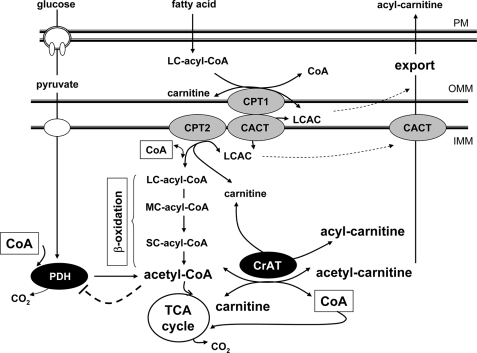FIGURE 9.
Proposed role of carnitine and CrAT in regulating mitochondrial energetics. TheLCAC product of CPT1 traverses the inner mitochondrial membrane (imm) via CACT and is then delivered to CPT2, which regenerates acyl-CoA on the matrix side of the membrane. The enzymes of β-oxidation degrade long chain acyl-CoAs to shorter species through a recurrent, multistep process that yields one two-carbon molecule of acetyl-CoA in each successive cycle. When acyl-CoA production exceeds consumption, these intermediates can be converted back to their acylcarnitine counterparts and exported from the mitochondria into the general circulation. CrAT, a mitochondrial matrix enzyme that prefers short-chain acyl esters, regulates mitochondrial metabolism by lowering the acetyl-CoA/free CoA ratio and regenerating free CoA, which is used by PDH and the tricarboxylic acid (TCA) cycle enzyme, α-ketoglutarate dehydrogenase. Futile production and export of LCAC might compromise the intramitochondrial pool of carnitine, thus limiting CrAT activity.

